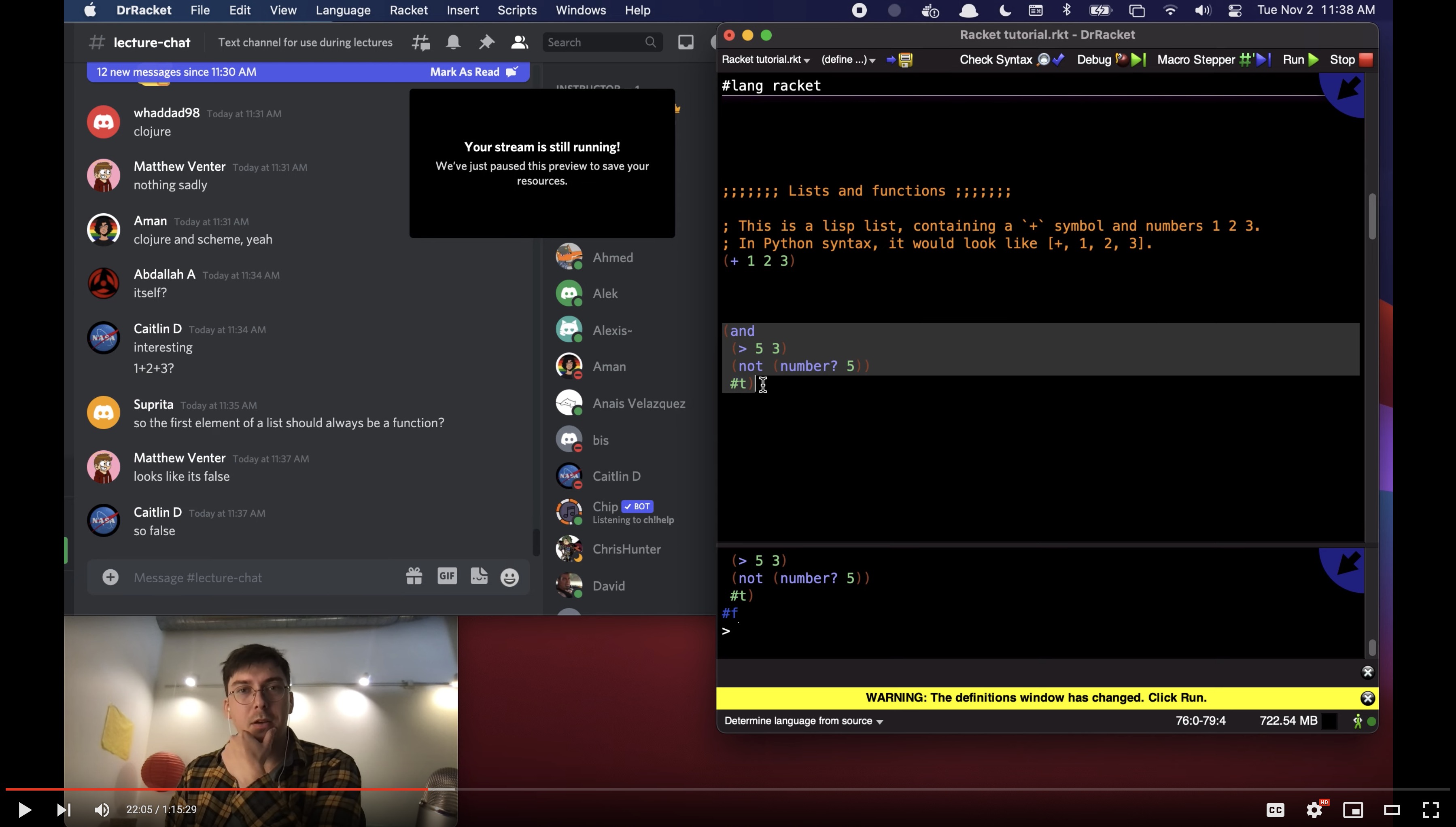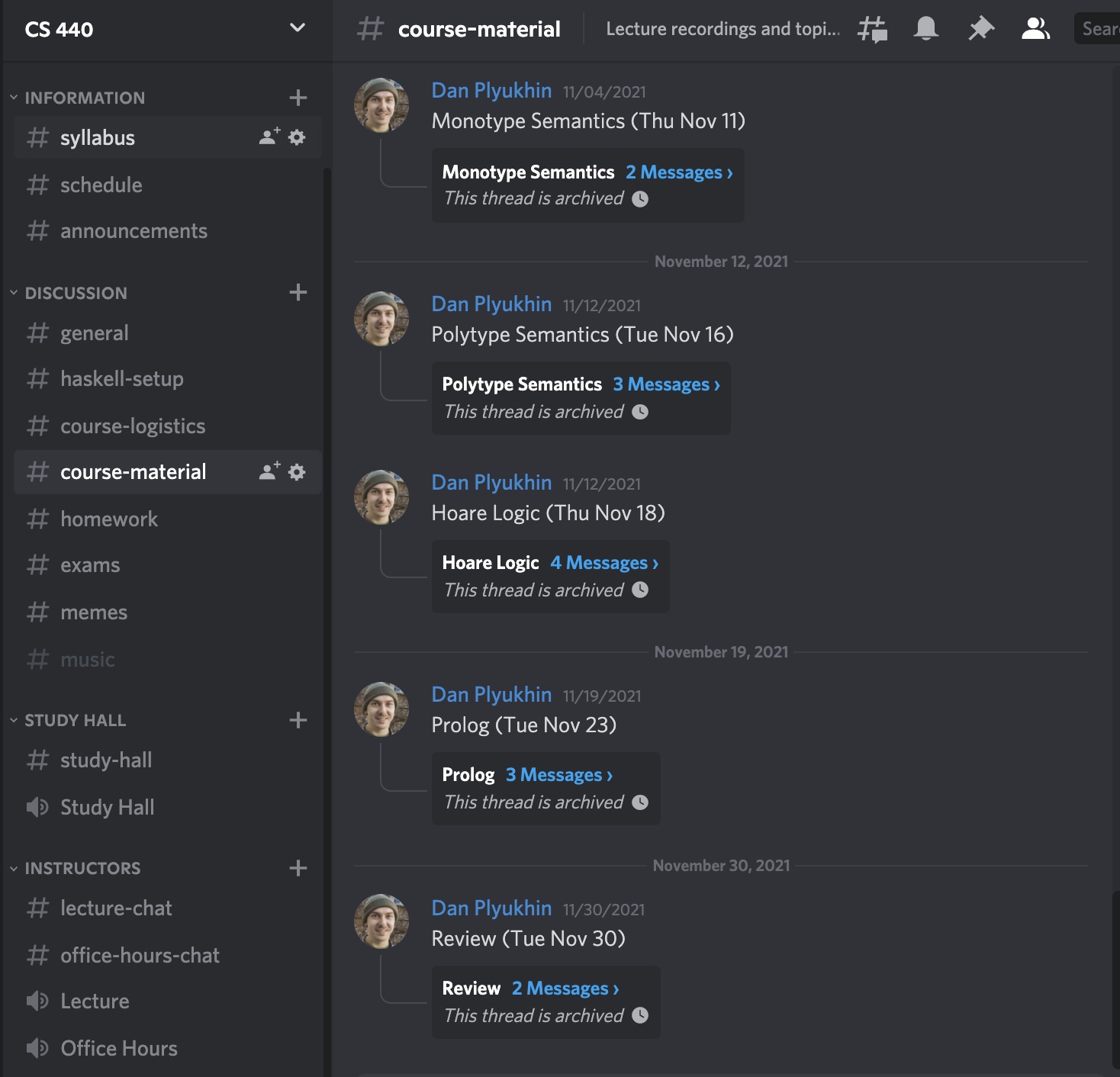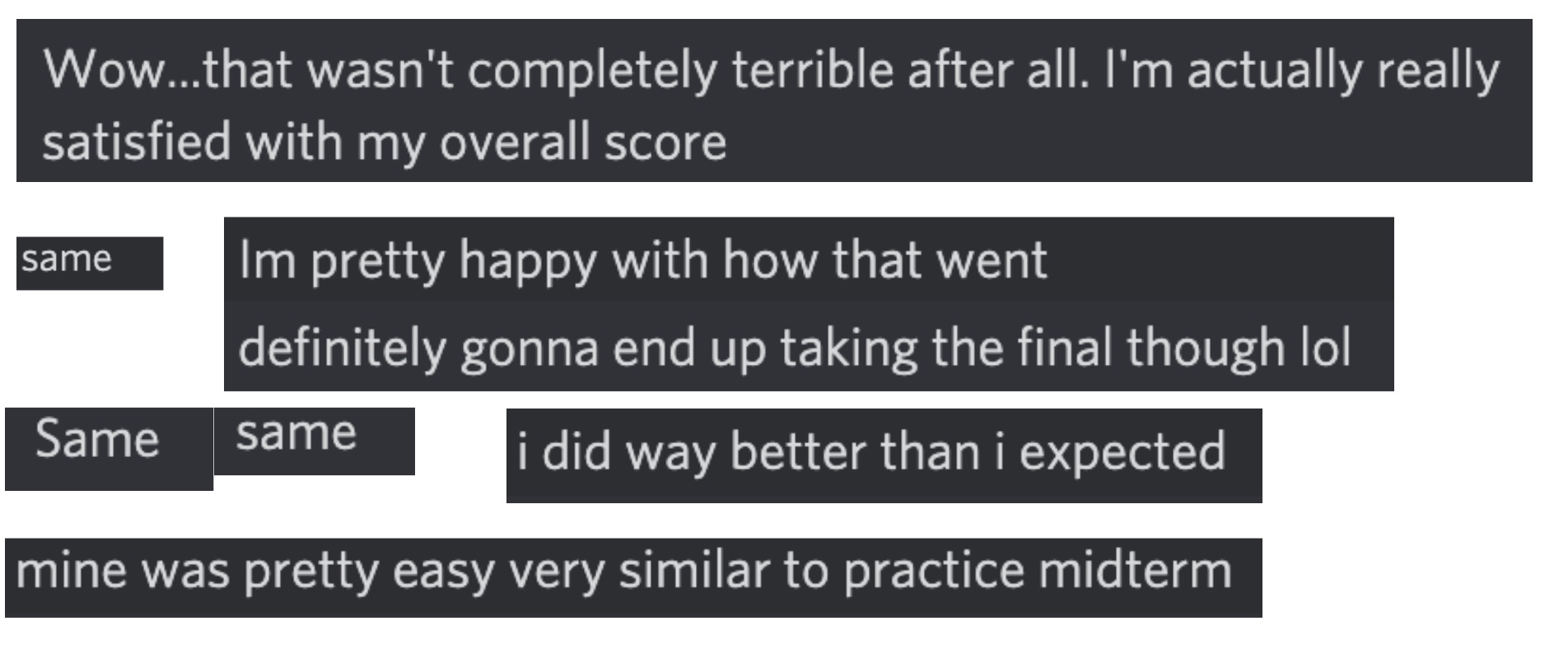What It's Like To Teach On Discord
Dan Plyukhin — Jan 10, 2022
View comments on: Hacker News | Reddit

It's been a few weeks since I submitted the final grades for CS 440, "Programming Languages and Translators" at Illinois Tech. This was the first course I ever taught as the lead instructor. Based on student feedback, I think it went quite well!
"Incredibly interesting course, taught in a really good format."
"This is by far the best core course I have this semester. I always come to lecture wanting to engage and leave with a little more understanding than I did before. It is a challenging but fair course and I feel 100% supported whenever I need help."
"Dan is one of the most compassionate, engaging and thought-provoking instructors I've ever had during my time at IIT."
Aren't they sweet? 🙂
I made a bold decision to run the whole course on just two apps: Discord and Prairielearn. This article is about why I did that, and how it went.
Why Discord?
Here's what I knew in advance:
- The course would have to be taught completely online;
- There would be ~50 synchronous students and ~10 asynchronous students;
- I would have access to numerous autograded assignments and exams on Prairielearn, graciously provided by Professor Mattox Beckman.
In my experience, online learning can lead to students and instructors becoming bored and demotivated. The first few lectures usually start out fairly strong, but then students gradually start to realize that it's more convenient to watch a recorded lecture than to attend during classtime. Many of those same students will then put off watching the recorded lectures, fall behind in class, and be too afraid to ask questions. Meanwhile, the professor watches attendance drop precipitously and also has increasing difficulty getting students to engage during classtime or on the course forum.
To avoid the same fate, I decided that my priority should be to maximize student engagement. Here are the design goals I used to try and achieve that:
- Make it less stressful to join lecture. E.g. Don't bother asking students to turn on video. I don't find the benefits to outweigh the inconvenience.
- Make it less stressful to contribute. People find it easier to type a comment than to speak. Design lectures around a chat window.
- Keep things casual. I think the formality of a typical in-person lecture does not translate well to an online setting. Make an effort to encourage jokes, memes, and even exasperation (within reason). Hopefully, this makes it less stressful for students to make mistakes.
- Use good technology. See Professor Challen's essay, Why I Don't Use Piazza. How do we know Discord is "good technology"? Because people actively choose to use Discord in their free time.
- Keep lectures interactive. I used a sort of "inverted classroom" approach. Students were expected to watch a short video on the day's topic before coming to lecture. Classtime was spent using the Socratic method to dive deeper into the topic.

I think Discord works well with those design goals. Joining lecture is as easy as clicking on the "Lecture" voice channel. People are used to being casual and having fun on Discord, moreso than on Slack. Discord also supports bots, which can do interesting things. For example, we used Chip to play music before lecture.
Next, I'll get into how that experience went, overall.
Technical Limitations
For those considering a similar approach as mine, here are a couple of problems I ran into early on.
Video Limits. Discord supports video calls --- but limited to just 25 people. It also has a "Go Live" feature, where only one person can have their video on. During the pandemic, the limit for Go Live was increased to 50 people. I used video calls for office hours and Go Live for lectures. For classes larger than 50, I might suggest using Twitch for lectures instead of Zoom or Discord.
Limited file hosting. Discord's free plan has an 8MB file upload limit. This is good enough for PDFs and screenshots, but definitely not for video recording. I uploaded my recorded video lectures onto YouTube as "unlisted" videos. Luckily, Discord automatically embeds video links, so students could watch lectures without explicitly opening up YouTube.
The Good
Look at these testimonials!
"I really like how the class is on Discord. It allows me to easily ask for help."
"The way the course is structure[d] not only promotes student engagement but encourages students to help one another as well."
I succeeded in keeping lecture attendance and engagement fairly high throughout the semester. Attendance in the first month was consistently around 40-50 students, and by the end of the semester it dropped to around 20-30. This was enough that I always had a decent number of students asking for clarifications and responding to my questions. Considering they could easily have skipped class and watched the recordings on their own time, I see this as a roaring success.

Less easily measurable, I think that Discord improved the quality of discussion in comparison to Piazza or Campuswire. My students were extremely supportive of one another and maybe even made a couple of friends by the end of the semester. I think the instant-messaging nature of Discord made it less scary to ask questions, suggest solutions, or have general discussions.
There are also a few perks as an instructor.
First: You get to feel like a famous Twitch streamer.
Second: You get to receive DMs like this:

The Bad
Unfortunately, there's no silver bullet. While most of the feedback I received was positive, a couple of students disliked the inverted classroom approach.
"I like to just watch a lecture and take notes, then go work through things on my own."
"[T]his course employs most unnecessarily hair-brained [sic?] structure I've ever seen. ... "
One real issue that came up was that, as the semester went on, students were less likely to watch the prerequisite video before lecture. This meant that I had to spend more time explaining the basic concepts during class, rather than exploring their deeper implications. As one anonymous student commented:
"For any given student, there's 2 main outcomes and [n]either is great. If they do the video lecture and handout before class, the lecture is just a boring and overlong rehash of the same material ... If the student doesn't do the prework, it doesn't matter. The material gets taught anyway. The fact encourages the second pattern of behavior. That goes back to a truth that so many people with advanced degrees just can't seem to get through their heads. Most students will not do work unless they think it's worth their time."
Again, I had many more comments in favor of the inverted classroom. I think it's a more natural fit for interactive online learning. However, I think the criticism is valid and difficult to resolve. As we optimize learning for some students, will we inevitably lose others?
Another issue was organizational. I tried to organize discussion by creating text channels for every lecture topic, homework assignment, and exam. Students used those channels correctly at first, but by the end of the semester most discussion had moved into the catch-all #study-hall channel. If the class size was any larger, this would have become completely unmanageable. Maybe my mistake was having a catch-all channel in the first place?
The Ugly
Although I stand by my assertion that class discussion should be less formal, this decision did have negative consequences.
One afternoon I had a student take the midterm early, due to a time conflict. Unfortunately, they didn't do very well on the exam and posted about it on Discord. When I checked on the app an hour later, I found a riot taking place with a hundred or so messages. Here are a few selections to give an impression.

I quickly shut the discussion down and expressed that I expected more maturity on the server. Later that week, the students' fears turned out to be unfounded:

Nevertheless, this experience took a pretty serious emotional toll on me. It's hard to feel like you're letting your students down.
I don't think the situation would have played out this way if I hadn't used Discord. The dark side of keeping a fun, casual environment is that negative stimuli can cascade into avalanches of high emotion and misinformation. When designing a community to have these positive aspects, it's important to defend against the negative aspects. Twitter is a good example of a community facing similar pressure.
Conclusion
I've focused a lot on the negative aspects here because I think those are the most important to communicate. However, overall I would say that teaching on Discord was a positive experience. Having engaged, curious, playful students is the gold standard for teaching and I think we achieved that.
Of course, this is all anecdotal evidence. I might have made different decisions if I was teaching a different class size or a different class. If you taught or are planning to teach a course with Discord, I hope my report gave you something to think about. Feel free to drop me a line if you want to discuss this further.